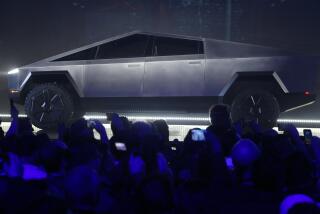Technology Rolls On at OCTD : It’s a Bus, a Truck; No, It’s SuperBus!
- Share via
An innovative vehicle that is part bus, part tractor-trailer was unveiled Thursday by Orange County Transit District officials who plan use it to transport passengers on the district’s Fullerton-to-Los Angeles freeway route.
The low-slung trailer portion of the vehicle, called SuperBus, is more comfortable, larger, longer, and consequently holds more passengers than conventional buses owned by the district, transit spokeswoman Claudia Keith said.
“The transit district is always looking for the latest technology and this is a step in that direction,” Keith said.
Compared to standard buses, which are 40 feet long and hold up to 44 passengers, the SuperBus trailer is 46 feet long and can carry up to 58 passengers.
Three-Year Lease Signed
The brainchild of a Buena Park inventor, the bus is pulled by a conventional truck tractor. The driver can monitor activities in the passenger area by means of a television setup.
The district has signed a three-year lease as part of a pilot program to test two of the new carriers. The lease will cost $4,020 per vehicle monthly.
Operation is expected sometime in the spring on the OCTD’s Route 464, a 22-mile, one-way trip using Interstate 5 from the Fullerton Park and Ride to downtown Los Angeles. No firm starting date has been set.
Compared to regular buses, maintenance and operating costs are lower for the new vehicle, according to Richard Edgar, OCTD board member and a Tustin City Council member.
“In addition, the passenger portion of the bus has double the service life of a regular bus and also has the space to hold more passengers. That could mean significant reductions in capital and operating costs down the line,” Edgar said.
Inventor Joseph M. FitzGerald has estimated that maintenance and operating costs for conventional buses could be reduced by up to 40% annually with the new bus. Overall costs per mile, including parts, labor and fuel, now run from 47 to 52 cents, Keith said.
It is the low costs and additional passenger space that have stirred interest at transit districts and airports throughout the nation, said FitzGerald, who refers to his SuperBus as a “power module and passenger module.”
The trailer unit has no high entry step, which is more convenient for senior citizens than conventional buses and eliminates the need for a lift gate for the handicapped, FitzGerald said.
FitzGerald also points out that the tractor-trailer has a shorter turning radius than a regular bus.
A 27-foot prototype was made in 1984, after FitzGerald toyed with the idea for about seven years. FitzGerald is chairman of the board of Nose Cone Inc., a Buena Park manufacturer of aerodynamic wings and cones used on trucks and buses.
In December, 1985, OCTD tested the shorter, 27-foot SuperBus for one week. Rider surveys indicated wide acceptance by passengers and drivers, Keith said.
‘Passengers Really Liked It’
“We learned that the passengers really liked it a lot because it is more spacious and the ride was comfortable. The drivers liked it as well,” Keith said.
About $2 million has been invested in the SuperBus project since 1984, when prototypes were built by Utility Trailer and Diamond B, both located in California, said SuperBus President James F. Elder, speaking by telephone from the company’s offices in San Jose.
“We’re just coming out of the R and D (research and development) stage now,” Elder said.
If successful, the trailer modules will be mass-produced, Elder said. American-made components such as doors, windows, axles and metal extrusions would be shipped to Mexico City for assembly, and from there the modules would be brought back to the United States.
More to Read
Sign up for Essential California
The most important California stories and recommendations in your inbox every morning.
You may occasionally receive promotional content from the Los Angeles Times.










